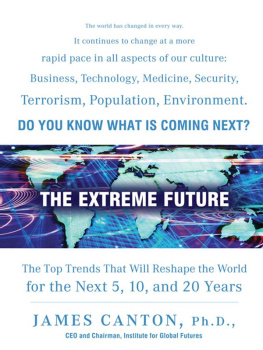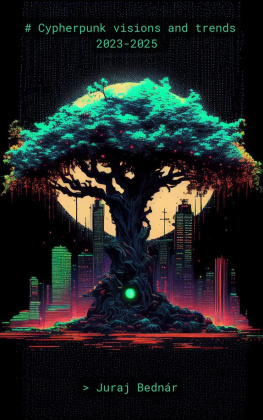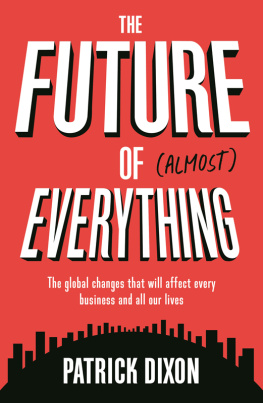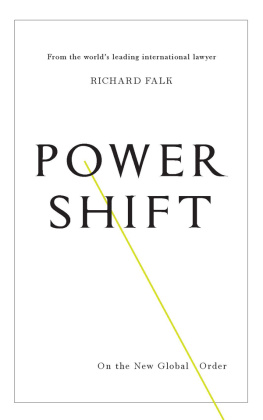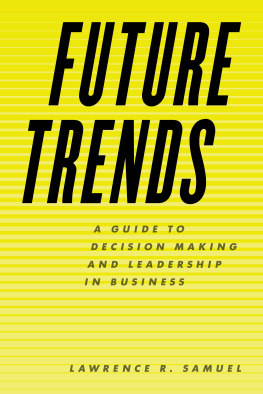THE
EXTREME FUTURE
The Top Trends That Will Reshape the World
for the Next 5, 10, and 20 Years
JAMES CANTON, PH.D.

DUTTON
DUTTON
Published by Penguin Group (USA) Inc.
375 Hudson Street, New York, New York 10014, U.S.A.
Penguin Group (Canada), 90 Eglinton Avenue East, Suite 700, Toronto, Ontario M4P 2Y3, Canada (a division of Pearson Penguin Canada Inc.); Penguin Books Ltd, 80 Strand, London WC2R 0RL, England; Penguin Ireland, 25 St Stephens Green, Dublin 2, Ireland (a division of Penguin Books Ltd); Penguin Group (Australia), 250 Camberwell Road, Camberwell, Victoria 3124, Australia (a division of Pearson Australia Group Pty Ltd); Penguin Books India Pvt Ltd, 11 Community Centre, Panchsheel Park, New Delhi 110 017, India; Penguin Group (NZ), cnr Airborne and Rosedale Roads, Albany, Auckland 1310, New Zealand (a division of Pearson New Zealand Ltd); Penguin Books (South Africa) (Pty) Ltd, 24 Sturdee Avenue, Rosebank, Johannesburg 2196, South Africa
Penguin Books Ltd, Registered Offices: 80 Strand, London WC2R 0RL, England
Published by Dutton, a member of Penguin Group (USA) Inc.
Copyright 2006 by James Canton, Ph.D.
All rights reserved
 REGISTERED TRADEMARKMARCA REGISTRADA
REGISTERED TRADEMARKMARCA REGISTRADA
LIBRARY OF CONGRESS CATALOGING-IN-PUBLICATION DATA HAS BEEN APPLIED FOR.
ISBN 978-1-1012-1349-0
Without limiting the rights under copyright reserved above, no part of this publication may be reproduced, stored in or introduced into a retrieval system, or transmitted, in any form, or by any means (electronic, mechanical, photocopying, recording, or otherwise), without the prior written permission of both the copyright owner and the above publisher of this book.
The scanning, uploading, and distribution of this book via the Internet or via any other means without the permission of the publisher is illegal and punishable by law. Please purchase only authorized electronic editions, and do not participate in or encourage electronic piracy of copyrighted materials. Your support of the authors rights is appreciated.
While the author has made every effort to provide accurate telephone numbers and Internet addresses at the time of publication, neither the publisher nor the author assumes any responsibility for errors, or for changes that occur after publication. Further, the publisher does not have any control over and does not assume any responsibility for author or third-party Web sites or their content.
For Mariah, Sofia, and Trevor,
my three treasures.
INTRODUCTION
The White House
O n a warm spring day in June 2002, I approached the White House with a mix of anticipation and curiosity. I had been invited along with a small group of CEOs from IBM, AT&T, and other U.S. corporations to meet with President George W. Bush and his cabinet to discuss one of the central challenges of our time: How should we think differently about the future?
It was a question that had been on the mind of almost every American for the previous nine months. The 9/11 attacks had destroyed more than the lives of those killed by the terrorists. It had drastically altered Americas vision of the future by introducing uncertainty and fear into our culture for the first time in generations. The deadly assault on the symbols of American economic and military might exposed our vulnerability and shattered our reality. The almost infinite optimism about the future, so central to the American psyche, was damaged that day along with the World Trade Center towers and the Pentagon. Yet still, here we were.
As I filed past security and entered the back of the Oval Office, I could sense a keen anxiety building in the room. I had been asked ahead of time to prepare a briefing for the president and his advisors, which I had done. So they knew my perspective; now I wanted to hear theirs. I looked around and saw the blue and gold seal of the office of the president, with its bald eagle resting proudly on the podium. The stage was set. As each cabinet member marched in to describe his or her key challenges in such areas as education, energy, security, and health care, the very nature of their comments made it apparent that a transformation was under way. They brought up the inability of computer databases to work together, the lack of trained people to inspect the nations food supply, the immensity of security issues, and the work yet to be done to protect the nation. The room buzzed with the barely suppressed excitement that comes with the rare experience of hearing straight talk in the halls of power. This was our post-9/11 briefing. We were at the beginning of a sea change. We could all feel it. Americas leaders, as well as most Americans themselves, had begun to recognize that nothing would be the same. Everything after 9/11 was a clean slate. There was a new complex future emergingan Extreme Future of disruptions, risks, threats, and perhaps, new opportunitiesthat no one, not even our leaders, fully understood.
A door opened suddenly and in walked President Bush. His first words took me by surprise: We know we do not have all of the answers, he told us. We need your help in preparing the nation for the future. Few of us in the room were prepared for the president of the United States to address us in such a candid way. In that moment, my realization of the nations immense challenges that will confront us all in the future inspired me to write this book.
D R. J AMES C ANTON
San Francisco
Institute for Global Futures
www.GlobalFuturist.com
THE
EXTREME FUTURE
THE TOP TEN TRENDS OF THE EXTREME FUTURE
1. Fueling the Future The energy crisis, the post-oil future, and the future of energy alternatives like hydrogen. The critical role that energy will play in every aspect of our lives in the twenty-first century.
2. The Innovation Economy The transformation of the global economy based on the convergence of free trade, technology, and democracy, driving new jobs, new markets, globalization, competition, peace, and security. The Four Power Tools of the emerging Innovation Economy are Nano-Bio-IT-Neuro.
3. The Next Workforce How the workforce of the U.S. is becoming more multicultural, more female, and more Hispanic. Why the future workforce must embrace innovation to become globally competitive.
4. Longevity Medicine The key forces that will radically alter medicine, such as nanotech, neurotech, and genomics, leading to longer and healthier lives.
5. Weird Science How future science will transform every aspect of our lives, culture, and economyfrom teleportation to nanobiology to multiple universes.
6. Securing the Future The top threats to our freedom and our lives, from criminals to terrorists to mind control. Defining the risk landscape of the twenty-first century.
7. The Future of Globalization: Cultures in Collision The new realities of global trade and competition; the rise of China and India; the clash of cultures and values; and the ideological battle for the future.
8. The Future of Climate Change How the environment is changing and how we need to prepare for increased global warming, pollution, and threats to health. How we must change.
9. The Future of the Individual Navigating the threats from technology, governments, and ideologies in the struggle for human rights, liberty, and the freedom of the individual in the twenty-first century.
10. The Future of America and China How the destiny of these two great nationsfrom capitalism to democracy, to innovation and securitywill shape the future.

